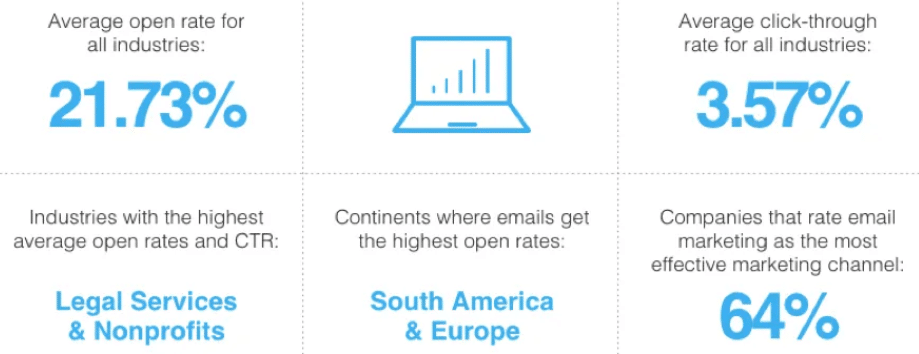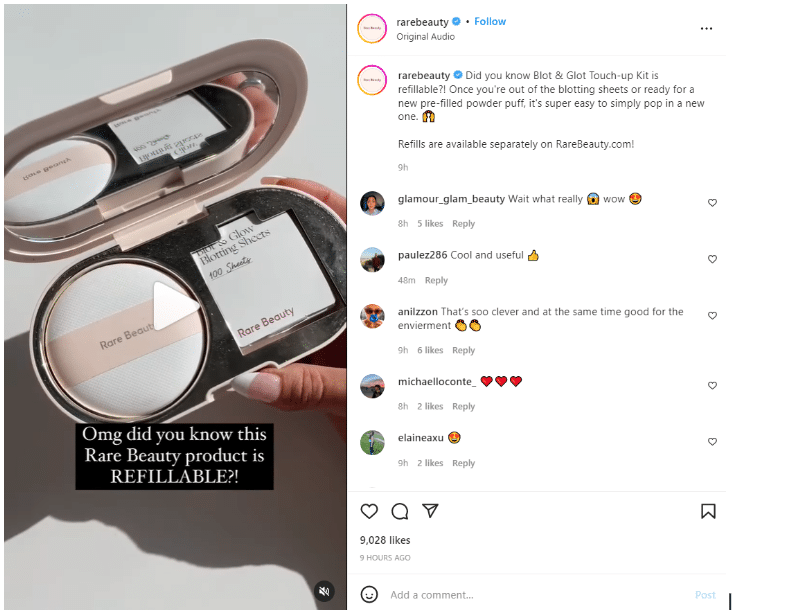2. Email Marketing vs Social Media: Audience Targeting and Reach
TL;DR: Email marketing provides a direct way to reach subscribers who’ve opted in, ensuring personalized communication. Its limitation, though, is that its reach only extends to the size of your email list.
Social media marketing, on the other hand, offers access to a vast and varied audience globally, taking advantage of the extensive time users spend online. However, social media algorithms can sometimes restrict how many people actually see your posts. Combining both strategies can be effective, using social media to grow your audience and email to maintain targeted, direct communication.
A. Email Marketing: Audience Targeting and Reach
Can you guess the biggest advantage of email marketing? That’s owning your email list. No algorithms are affecting your metrics and hiding your content from recipients. If you comply with key email regulations and follow the best deliverability practices, your emails will reach your subscribers’ inboxes.
However, the extent of your reach is limited to the number of email addresses you manage to collect from your audience.
In email marketing, there are specific metrics that help you measure your email reach including:
- Number of subscribers: How many people are on your email list.
- List growth rate: How fast your email list is growing.
- Unsubscribe rate: The percentage of people who leave your email list.
- Open rate: How many people open your emails.
- Click-through rate (CTR): How many people click on links in your emails.
Not all industries have the same open and click-through rates, though.
Here are some interesting email marketing facts:
- Average open rate for all industries: 21.73%
- Average click-through rate for all industries: 3.57%
- Industries with the highest average open rates and CTR: Legal Services & Nonprofits
- Continents where emails get the highest open rates: South America & Europe
- Companies that rate email marketing as the most effective marketing channel: 64%

Considering the average email open rate, if you have 1,000 recipients, you can expect 217 of them to open your emails. The catch might be obvious. Despite its targeting capabilities, email marketing’s reach is limited to the contacts in your email list.
You can always grow your email list and expand your reach to a wider audience, but it will take some time and effort to get there. With the right email practices in place, you can increase the number of people interacting with your email content.
Email marketing shines when it comes to precision targeting and personalized communication. Email marketing solutions allow brands to segment their recipients based on specific criteria like their demographics, browsing habits, or engagement level. This kind of data helps marketers create highly relevant promotions, recommendations, or educational content using dynamic content blocks.
B. Social Media Marketing: Audience Targeting and Reach
Social media is a powerful tool for brands to reach lots of different people. People around the world spend around 143 minutes daily on social media. This gives brands a good chance to grab the attention of potential customers.
Many users interact with brands on social media. Interaction isn’t just about looking at posts; it also includes messaging brands directly for things like customer service.
To measure audience reach and engagement on social media, use the following key metrics:
- Impressions: Counts how many times your content is displayed.
- Reach: The number of unique viewers who see your content.
- Engagement Rate: A combination of all interactive activities (likes, comments, shares) relative to your number of followers or reach.
- Click-Through Rate (CTR): The percentage of viewers who click on a link in your post.
- Follower Growth Rate: Tracks how quickly you’re gaining new followers.
However, there are challenges. Social media sites use algorithms that might limit how many people see your posts unless they are already popular. Despite being an affordable option, it’s hard for a brand to stand out because there’s so much content out there.
To overcome these challenges, brands can create content that gets people to interact, like sharing or commenting, which can help more people see their posts. Also, paid ads can help ensure that the right people see your content, with targeting features that allow you to set everything from location and age to interests and preferences.
In contrast to social media, email marketing offers a way to talk directly to people who have chosen to hear from you, usually resulting in better responses. Email lets you control your message and reach people directly in their inboxes.
Bottom line: Using both social media and email together is usually the best digital marketing strategy. For instance, you can use social media to attract new followers with free offers or useful resources they can access by providing their email addresses, and then use email marketing to send them more personalized messages and convert them into customers.
3. Email Marketing vs Social Media: Engagement and Interaction
TL;DR: Email marketing is all about sending personalized emails to keep in touch with your audience. It’s great for building strong connections, but it doesn’t offer instant interactions like comments or shares that can boost your visibility. On the other hand, social media is fantastic for quick, real-time engagement. People can like, share, or comment on posts, helping your content reach more people quickly.
A. Email Marketing: Engagement and Interaction
In email marketing, subscriber engagement is all about delivering high-quality and personalized email content. Emails can be tailored to specific audience segments, delivering relevant offers and news directly to their inboxes. This personal approach fosters stronger connections, which, in turn, increases the likelihood of engagement.
Not to mention that you can use email automation to set up automated emails triggered by specific actions, such as someone subscribing to your list or abandoning their cart. This is an excellent way to target your audience at the right time, maintaining engagement throughout the customer journey.
But unlike social media channels that offer real-time interactions, email marketing doesn’t promote immediate engagement. You don’t get options like shares, retweets, mentions, or comments. So, email marketing may lack the potential for the rapid spread of content that social media offers.
But there are ways to maximize email engagement:
- Focus on creating eye-catching and straightforward subject lines to get readers to open your email.
- Incorporate interactive elements like GIFs, polls, or surveys into your emails to make them more engaging and encourage interaction.
- Include compelling and prominent CTAs to guide recipients toward desired actions like downloading content or making a purchase.
B. Social Media Marketing: Engagement and Interaction
Social media marketing is the king of engagement. On social media, your followers engage with your brand in real-time using likes, mentions, shares, etc. Social media marketers may reply to comments directly, establishing deeper connections.
Social media posts often include interactive content such as videos or memes. This type of content goes easily viral and entices users to click through to your website.
When users like, share, or comment on your post, a certain number of their followers will see it, even if they don’t follow your brand themselves. That way, your content gains more exposure compared to what you’d get with an email.
But just because social media marketing has the potential for viral reach, it doesn’t guarantee results.
The success of a social media campaign depends on factors like your content quality, the audience targeted, and its timing. That’s why it’s important to actively engage with your audience by responding to comments and messages promptly.
Try to keep your posting schedule consistent to stay top of mind and leverage insights to determine optimal posting times. Also, invest in running regular series like a social media contest to increase visibility and encourage users to share their experiences with your brand through user-generated content.
4. Email Marketing vs Social Media: User Preferences
TL;DR: Email marketing is effective because recipients expect updates from brands they trust, but it’s crucial to keep these emails frequent enough to be remembered without becoming spammy. In contrast, social media marketing must capture attention in a competitive space, using real-time interaction and a mix of engaging content to keep followers interested.
While email is about maintaining interest with valuable content, social media is about standing out and engaging actively with the audience.
A. Email Marketing: User Preferences
Email has been around for almost half a century. As a result, the number of email users worldwide is beyond imagination—in fact, there are 4.4 billion users as we speak.
Everyone who opts in to receive email promotions from your business expects this type of content to land in their inboxes. So, they’re less likely to get annoyed by your emails. In fact, many users appreciate the direct nature of email and its convenience for receiving updates from brands they trust.
But be careful not to overwhelm your recipients with promotions, though. Sending too regular or irrelevant email content could lead them not to read your email—or even worse, move it to the trash folder.
To prevent this from happening, ensure you share valuable content like industry news, tips, and educational content that show your expertise. Also, be mindful of your email frequency. You should strike a balance between keeping your brand top of mind and annoying them with too many or uninspiring emails.
B. Social Media Marketing: User Preferences
More than 2.5 billion people globally use social media daily. That’s an infinite pool of prospective customers for your brand.
Unfortunately, not all your followers will read every post, let alone like, comment, or share your news. With so many brands fighting for their attention, it will be challenging to cut through the noise. How will you ensure they’re on the lookout for your posts, tweets, or pins?
For starters, think of social media as a place to connect with your followers and boost brand awareness rather than selling your products or services excessively.
What people love on social media is active and instant communication with their favorite brands. Use this to your advantage by leveraging interactive features like Instagram Stories, Facebook Live, or polls to interact with your audience in real-time. Share exciting content like quick tips, behind-the-scenes videos, or fun memes to catch their attention.
To keep your content strategy balanced, consider creating content pillars and diversifying your strategy to keep your audience engaged.
Here’s how you can use the 4-1-1 rule to plan your social media content:
- Share four pieces of educational or entertaining content to engage your audience.
- Post one soft promotion to subtly introduce your products or services.
- Launch one hard promotion to directly encourage sales or sign-ups.
Four pieces of educational or entertaining content
When you’re planning your social media content with the 4-1-1 rule, it’s all about striking the right balance between engaging, informing, and selling. Let’s break it down.
Start with the four pieces of educational or entertaining content. This is your chance to really engage your audience without making a sales pitch. You could share some interesting articles, whip up a few how-to videos, keep everyone updated with the latest industry news, or sprinkle in some fun facts or eye-catching infographics. These are great ways to keep your audience interested and show that you’re in tune with what matters to them.

What’s great about this example is that it uses a clear, bold graphic to guide students on where to look for scholarship information. The clean design keeps things straightforward, making it super easy for students to get the message quickly without any fuss.
One soft promotion
Now, for the soft promotion, think subtle. Maybe post a customer testimonial or a case study that shines a light on the benefits of your products. You could also let people peek behind the curtains with some behind-the-scenes content, or share stories about your wonderful employees. It’s all about making that connection without the hard sell.

The employee spotlight video brings a personal touch that humanizes the company. It pulls viewers into the company culture, making the brand feel more relatable and approachable.
One hard promotion
And finally, your hard promotion. This is where you get to be bold and direct. Encourage your followers to sign up for a webinar, buy a product, or jump on a special offer. Whether it’s launching a new product or running a cool contest, it’s your moment to turn those followers into customers.

The Instagram post by Rare Beauty effectively highlights and promotes the refillable feature of one of their beauty products, tapping into a growing consumer interest in sustainability. This straightforward presentation not only educates viewers on the product’s eco-friendly features.




